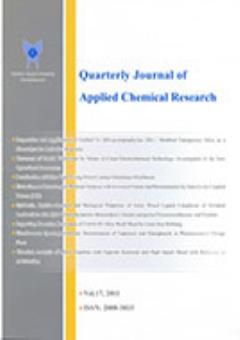A Simple Polymer-based Co-Precipitation Method for Tuning Magnetic Properties of Cobalt-Doped Nickel Ferrite Nanoparticles
محورهای موضوعی : نانو
1 - Department of Advanced Technologies, University of Mohaghegh Ardabili, Namin, Iran
کلید واژه: Polymer, Co-precipitation, Magnetic nanoparticles ,
چکیده مقاله :
Ion distribution on the spinel structure of ferrite nanoparticles is one of the critical factors that can affect magnetic properties. Therefore, if a method changes ion distribution, it can be used for fabrication (synthesis) of nanoparticles with different magnetic properties that apply in the diverse of technology field. In this work, the dependence of magnetic characteristics of the cobalt-doped nickel ferrite nanoparticles on Polyvinyl alcohol (PVA) assisted co-precipitation processes was studied. The structural and magnetic measurements were made employing XRD and VSM. Nanoparticles with a cubic spinel structure and an average size of about 29 nm have been synthesized, and their structure was confirmed using the XRD pattern and Sherrer’s equation. According to the obtained hysteresis loops of the five sets of synthesized nanoparticles, the coercive field and magnetization are different because of the interaction between polymer and metal ions in the reaction medium that causes a kind of ion immobilization and different ion distribution over the spinel structure. Such polymer-based synthesis procedures can be used to fabricate of magnetic nanoparticles with tunable magnetic properties.
Ion distribution on the spinel structure of ferrite nanoparticles is one of the critical factors that can affect magnetic properties. Therefore, if a method changes ion distribution, it can be used for fabrication (synthesis) of nanoparticles with different magnetic properties that apply in the diverse of technology field. In this work, the dependence of magnetic characteristics of the cobalt-doped nickel ferrite nanoparticles on Polyvinyl alcohol (PVA) assisted co-precipitation processes was studied. The structural and magnetic measurements were made employing XRD and VSM. Nanoparticles with a cubic spinel structure and an average size of about 29 nm have been synthesized, and their structure was confirmed using the XRD pattern and Sherrer’s equation. According to the obtained hysteresis loops of the five sets of synthesized nanoparticles, the coercive field and magnetization are different because of the interaction between polymer and metal ions in the reaction medium that causes a kind of ion immobilization and different ion distribution over the spinel structure. Such polymer-based synthesis procedures can be used to fabricate of magnetic nanoparticles with tunable magnetic properties.
1. Jayakumar T, Rajeevgandhi C, Anand P. Effect on magnetic behaviour of Ag and Cd doped cobalt ferrite nanoparticles prepared by glycine-assisted sol-gel auto combustion method.
J Alloys Compd. 2023; 962: 171098.
2. Mohana S, Sumathi S. Agaricus Bisporus Mediated Synthesis of Cobalt Ferrite, Copper Ferrite and Zinc Ferrite Nanoparticles for Hyperthermia Treatment and Drug Delivery. J Clust Sci. 2023. https://doi.org/10.1007/s10876-023-02471-2.
3. Sanko V, Şenocak A, Oğuz Tümay S, Demirbas E. A novel comparative study for electrochemical urea biosensor design: Effect of different ferrite nanoparticles (MFe2O4, M: Cu, Co, Ni, Zn) in urease immobilized composite system. Bioelectrochemistry. 2023; 149: 108324.
4. Mollarasouli F, Zor E, Ozcelikay G, Ozkan S A. Magnetic nanoparticles in developing electrochemical sensors for pharmaceutical and biomedical applications. Talanta. 2021; 226: 122108.
5. Narang S B, Pubby K, Nickel Spinel Ferrites: A Review. J Magn Magn Mater. 2021;519:167163.
6. Sharifi I, Shokrollahi H, Doroodmand M M, Safi R. Magnetic and structural studies on CoFe2O4 nanoparticles synthesized by co-precipitation, normal micelles and reverse micelles methods. J Magn Magn Mater. 2012; 324: 1854–1861.
7. Uyanga E, Hirazawa H, Sakai T, Bobrikov I A, Balagurov A M, Jargalan N, Sangaa D. Correlation between synthesis and physical properties of magnesium ferrite. J Sol-Gel Sci. Technol. 2020; 95:223–229.
8. Sivakumar P, Ramesh R, Ramanand A, Ponnusamy S, Muthamizhchelvan C. Synthesis and characterization of NiFe2O4 nanosheet via polymer assisted Co-precipitation method. Mater Lett. 2011; 65: 483–485.
9. Mirzaee S, Shayesteh S F, Mahdavifar S, Anisotropy investigation of cobalt ferrite nanoparticles embedded in polyvinyl alcohol matrix: A Monte Carlo study. Polymer. 2014;55: 3713-3719.
10. Mirzaee S, Shayesteh S F, Mahdavifar S, Hekmatara S H. Synthesis, characterization and Monte Carlo simulation of CoFe2O4/Polyvinylpyrrolidone nanocomposites: The coercivity investigation. J Magn Magn Mater. 2015; 393: 1–7.
11. Mirzaee S, Azad‑Kalandaragh M, Azizian‑Kalandaragh Y. Nonzero coercivity of Fe3O4/ polyvinyl alcohol nanocomposites synthesized by different polymer‑assisted co‑precipitation processes. Polym Bull. 2021; 78: 2177–2189.
12. Firoz Khan T, Naresh U, Ramprasad T, Jeevan Kumar R. Structural, Morphological, and Magnetic Properties of Cobalt-Doped Nickel Ferrite Nanoparticles, J of Supercond Nov Magn. 2021; 34: 797–803.
13. Chakradhary V K, Ansari A, Akhtar M J. Design, Synthesis, and Testing of High Coercivity Cobalt Doped Nickel Ferrite Nanoparticles for Magnetic Applications. J Magn Magn Mater. 2019; 469: 674-680.
14. Cullity B D, Stock S R. Elements of X-Ray Diffraction, 2014; 3th Edition, Pearson,U.S.
15. Mazen S A, Abu-Elsaad N I, Khadour A E, A comparative study of the structural and magnetic properties for Zn2+ and Ge4+ ions substituted nickel ferrites. J Magn Magn Mater. 2019; 491: 165562.
16. El Moussaoui H, Mahfoud T, Habouti S, El Maalam K, Ali M B, Hamedoun M, et al. Synthesis and magnetic properties of tin spinel ferrites doped manganese, J Magn Magn Mater. 2016; 405: 181-186.
17. Goldman A. Modern ferrite. 2006; Springer, Second Edition, Pittsburgh.
18. Naseri M G, Saion E B, Abasstabar Ahangar H, Shaari A H. Fabrication, characterization, and magnetic properties of copper ferrite nanoparticles prepared by a simple, thermal-treatment method. Mater Res Bull. 2013; 48: 1439-1446.


